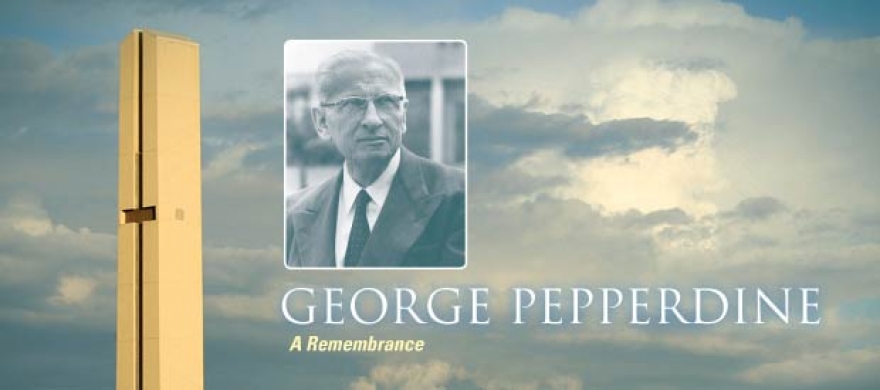George Pepperdine: A Remembrance
On the 50th anniversary of his passing, Pepperdine University remembers the life and legacy of its founder.
Seated near the central fountain on Pepperdine University’s Malibu campus is a bronze statue of founder George Pepperdine as if he has just paused to rest on a simple bench as hundreds of students hurry by on their way to class or to the student center or to meet friends. In his lap his Bible is opened to Jesus’ admonition that has captured the soul of the University through 75 years—“Freely ye received, freely give.
Mr. Pepperdine’s demeanor seems to bespeak his boyhood curiosity for learning how
things work, as well as the unstudied, natural humility with which he walked through
a full life, knowing incredible successes and disciplined to modesty by devastating
disappointments. Reared on a small Kansas farm where he trapped rabbits to be sold
to neighbors, he often labored in his father’s barn over childhood inventions, and
he attended a one-room country schoolhouse through the eighth grade. He was deeply
immersed in the rural community activities of small Church of Christ congregations
and his earliest memories were of his father, after a hard day’s labor in the field,
falling asleep by the fireplace in their one-room cabin with his Bible in his lap.
George was grown before he saw his first automobile, which he followed through town
on his bicycle with a fascination that was to shape his business career and, thankfully
for us, his legacy. In the early 1900s automobiles were sold without such “optional”
equipment as horns, kerosene tail lanterns, and canvas tops. So, with $5 to buy 500
one-cent postage stamps, he mailed out 500 simple circulars to owners of Ford autos
listing various items of equipment that he could order wholesale on consignment after
he had orders in hand (his profit the first month was $100). Within four years he
was publishing an entire catalog with colored pictures and an entire section of instructions
for making typical repairs that eventually became a virtual owners’ manual for the
15 million people who bought Model T autos from Henry Ford between 1909 and 1927.
Then, developing a kind of forerunner store with Wal-Mart prices and Nordstrom service
(“satisfaction or your money back”), he eventually could boast of Western Auto Stores
in over 300 cities with hubs in Kansas City, Denver, and Los Angeles. Having moved
to California for health reasons, he became a prominent civic leader, convinced that
Los Angeles was destined to become a major global city.
In 1937, the worst year of the Great Depression, Mr. Pepperdine gave $3 million (about
$50 million in today’s dollars) to establish Pepperdine College on 34 palm-shaded
acres on the Vermont Avenue streetcar line in South Los Angeles. He then placed the
majority of his fortune in a foundation to support not only the college but numerous
other programs for youth in need, as well as church mission efforts. When unwise decisions
made by the investment managers to whom he entrusted the foundation’s resources resulted
in Mr. Pepperdine losing virtually his entire fortune, he often told friends that
the only thing he had left in his waning years was what he had given away to found
Pepperdine College. And to the end of his life he often found peace and comfort when
he dropped in to talk with the students whose lives had been changed.
Mr. Pepperdine’s bronze replica is not alone. When one strolls the campus to pause
beside the names that adorn the University’s buildings and streets—and its endowed
scholarships and professorships—the experience is hauntingly similar to the encounter
with the list of Biblical heroes who populate the 11th chapter of Hebrews, beginning
with the faith of Abraham and those who followed, each of whom was a powerful instrument
for good in the hand of God. And like the author of the sacred scriptures, we too
are “surrounded by a great cloud of witnesses,” each bearing silent but eloquent testimony
to how one individual’s faith served as a powerful magnet to attract still greater
resources not visible before each solitary but heroic act of faith.
It is tempting when one passes George Pepperdine seated there among the students that
he loved, to engage him in conversation to ask if we have built wisely on his foundation
to alter the lives of those yet to pass by. But in this 75th year, as we pause to
express gratitude for the multitude of witnesses who surround us, it is surely appropriate
to acknowledge—simply, gratefully, and profoundly—that our lives also have been forever
changed.
